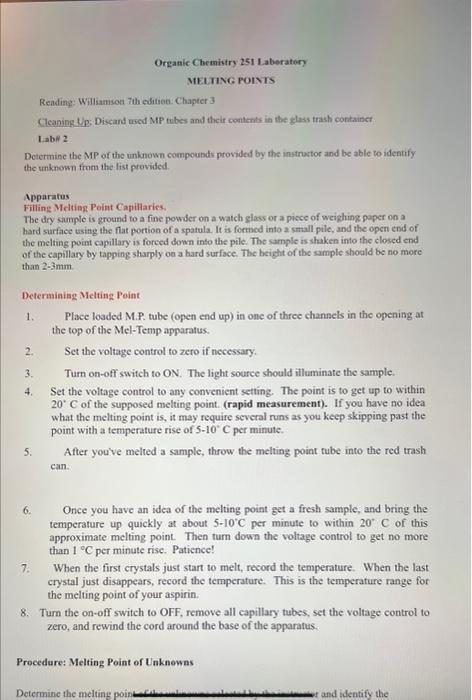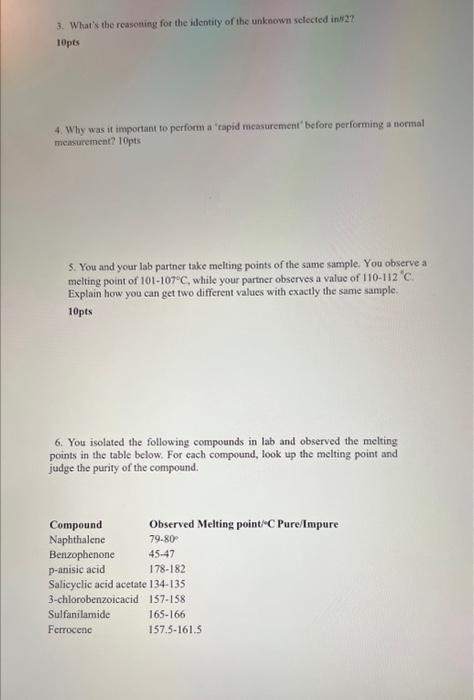Answered step by step
Verified Expert Solution
Question
1 Approved Answer
Just need the last 6 problems answered. Organic Chemistry 251 Laberatery MELTING POINIS Reading: Williamson 7ith edition. Chapter 3 Cleaning WP: Discand wed MP tubes
Just need the last 6 problems answered. 


Organic Chemistry 251 Laberatery MELTING POINIS Reading: Williamson 7ith edition. Chapter 3 Cleaning WP: Discand wed MP tubes and their contents in the glass trash contancef: Labn 2 Deterinine the MP of the unlanown compounds provided by the instractor and be able to identify the unknown from the list previded. Apparatus: Filling Melting. Point Capillaries. The dry sample is ground to a fine powder on a watch glass or a piece of weighing paper on a hard surface using the flat portion of a spatula. It is formed into a small pile, and the open end of the melting point capillary is forced down into the pile. The sample is shaken into the closed end of the capillary by tapping sharply on a hard surface. The beight of the sample shoald be no more than 23mm Deteraining Melting Point 1. Place loaded M.P. tube (open end up) in one of three channels in the opening at the top of the Mel-Tenp apparatus. 2. Set the voltage control to zero if necessary. 3. Turn on-off switch to ON. The light source should illuminate the sample. 4. Set the voltage control to any convenient setting. The point is to get up to within 20 C of the supposed melting point. (rapid measurement). If you have no idea what the melting point is, it may require several runs as you keep skipping past the point with a temperature rise of 510C per minute. 5. After you've melted a sample, throw the melting point tube into the red trash can. 6. Once you have an idea of the melting point get a fresh sample, and bring the temperature up quickly at about 510C per minute to within 20C of this approximate melting point. Then turn down the voltage control to get no more than 1C per minute rise. Patience! 7. When the first crystals just start to melt, record the temperature. When the last crystal just disappears, record the temperature. This is the temperature range for the melting point of your aspirin. 8. Tum the on-off switch to OFF, remove all capillary tubes, set the voltage control to zero, and rewind the cord around the base of the apparatus. Procedure: Melting Point of Unknewns Procedure: Melting Point of Unkmowns Determine the meltime point of the anknowns selected by the instruclot and identify the suhstance based on its melting point (table will be provided). Prepare two capillarics of each unknownt. Run a very fast determination on the first sample to ascertain the approximate meiting poinL. Since the MP of the mixture is unknown the first run (a rapid measurement) (about 15 to 20C per tuinute) is done to determine an approximate melting point. Then do the normal measurement on a fresh sample using the approximate meling point as your expected melting porint. Finsure that the melting point bath is Cool to just below the melting point and make a slow, careful determination usitle the other capillary. Labili (lab Report) 1. What is the meltimg point of the unknown? 5pts 2. What is the identity of the unknown based on the list provided? 5p ts 3. What's the reasoning for the identity of the unknown selected in 2 ? 10pts 4. Why was it important to perform a 'rapid measurement' before performing a normal measurement? 10pts 5. You and your lab partner take melting points of the same sample. You observe a melting point of 10I107C, while your partner observes a value of 1101124C. Explain bow yoa can get two different values with exactly the same sample. 10pts 6. You isolated the following onmpounds in lab and observed the melting 3. What's the reasoruing for the identity of the unknown selected inv2? 10pts 4. Why was it important to perform a 'rapid measuremeat" before performing a thormal measuremeat? 10pts 5. You and your lab partner take melting points of the same sample. You observe a melting point of 101-107 C, while your partner observes a value of 110112C. Explain how you can get two different values with exactly the same sample. 10pts 6. You isolated the following compounds in lab and observed the melting points in the table below. For each compound, look up the melting point and judge the purity of the compound. Organic Chemistry 251 Laberatery MELTING POINIS Reading: Williamson 7ith edition. Chapter 3 Cleaning WP: Discand wed MP tubes and their contents in the glass trash contancef: Labn 2 Deterinine the MP of the unlanown compounds provided by the instractor and be able to identify the unknown from the list previded. Apparatus: Filling Melting. Point Capillaries. The dry sample is ground to a fine powder on a watch glass or a piece of weighing paper on a hard surface using the flat portion of a spatula. It is formed into a small pile, and the open end of the melting point capillary is forced down into the pile. The sample is shaken into the closed end of the capillary by tapping sharply on a hard surface. The beight of the sample shoald be no more than 23mm Deteraining Melting Point 1. Place loaded M.P. tube (open end up) in one of three channels in the opening at the top of the Mel-Tenp apparatus. 2. Set the voltage control to zero if necessary. 3. Turn on-off switch to ON. The light source should illuminate the sample. 4. Set the voltage control to any convenient setting. The point is to get up to within 20 C of the supposed melting point. (rapid measurement). If you have no idea what the melting point is, it may require several runs as you keep skipping past the point with a temperature rise of 510C per minute. 5. After you've melted a sample, throw the melting point tube into the red trash can. 6. Once you have an idea of the melting point get a fresh sample, and bring the temperature up quickly at about 510C per minute to within 20C of this approximate melting point. Then turn down the voltage control to get no more than 1C per minute rise. Patience! 7. When the first crystals just start to melt, record the temperature. When the last crystal just disappears, record the temperature. This is the temperature range for the melting point of your aspirin. 8. Tum the on-off switch to OFF, remove all capillary tubes, set the voltage control to zero, and rewind the cord around the base of the apparatus. Procedure: Melting Point of Unknewns Procedure: Melting Point of Unkmowns Determine the meltime point of the anknowns selected by the instruclot and identify the suhstance based on its melting point (table will be provided). Prepare two capillarics of each unknownt. Run a very fast determination on the first sample to ascertain the approximate meiting poinL. Since the MP of the mixture is unknown the first run (a rapid measurement) (about 15 to 20C per tuinute) is done to determine an approximate melting point. Then do the normal measurement on a fresh sample using the approximate meling point as your expected melting porint. Finsure that the melting point bath is Cool to just below the melting point and make a slow, careful determination usitle the other capillary. Labili (lab Report) 1. What is the meltimg point of the unknown? 5pts 2. What is the identity of the unknown based on the list provided? 5p ts 3. What's the reasoning for the identity of the unknown selected in 2 ? 10pts 4. Why was it important to perform a 'rapid measurement' before performing a normal measurement? 10pts 5. You and your lab partner take melting points of the same sample. You observe a melting point of 10I107C, while your partner observes a value of 1101124C. Explain bow yoa can get two different values with exactly the same sample. 10pts 6. You isolated the following onmpounds in lab and observed the melting 3. What's the reasoruing for the identity of the unknown selected inv2? 10pts 4. Why was it important to perform a 'rapid measuremeat" before performing a thormal measuremeat? 10pts 5. You and your lab partner take melting points of the same sample. You observe a melting point of 101-107 C, while your partner observes a value of 110112C. Explain how you can get two different values with exactly the same sample. 10pts 6. You isolated the following compounds in lab and observed the melting points in the table below. For each compound, look up the melting point and judge the purity of the compound 


Step by Step Solution
There are 3 Steps involved in it
Step: 1

Get Instant Access to Expert-Tailored Solutions
See step-by-step solutions with expert insights and AI powered tools for academic success
Step: 2

Step: 3

Ace Your Homework with AI
Get the answers you need in no time with our AI-driven, step-by-step assistance
Get Started


